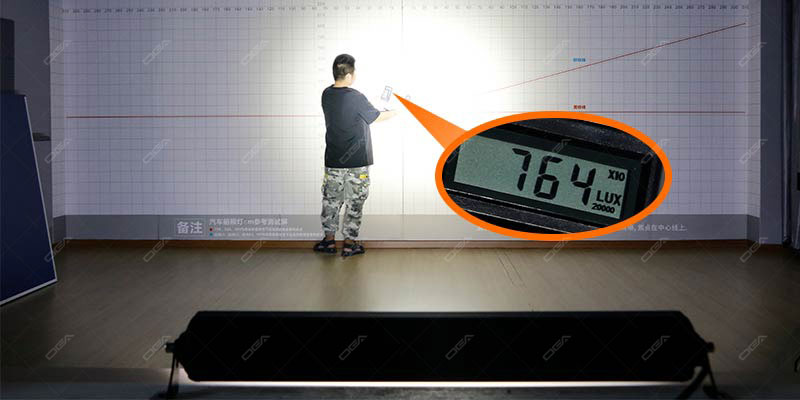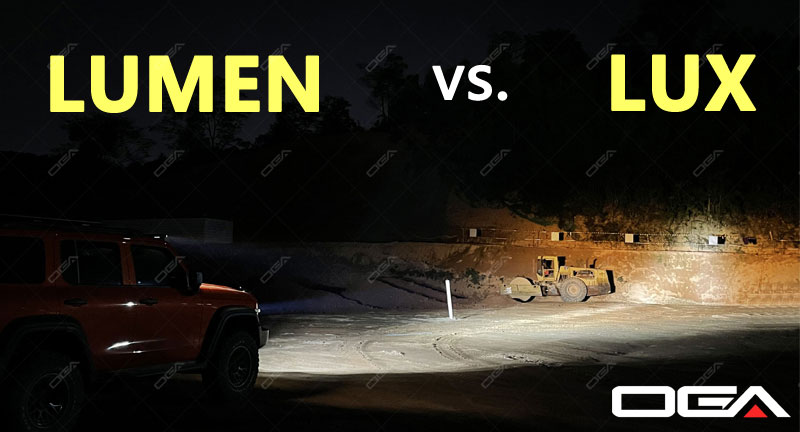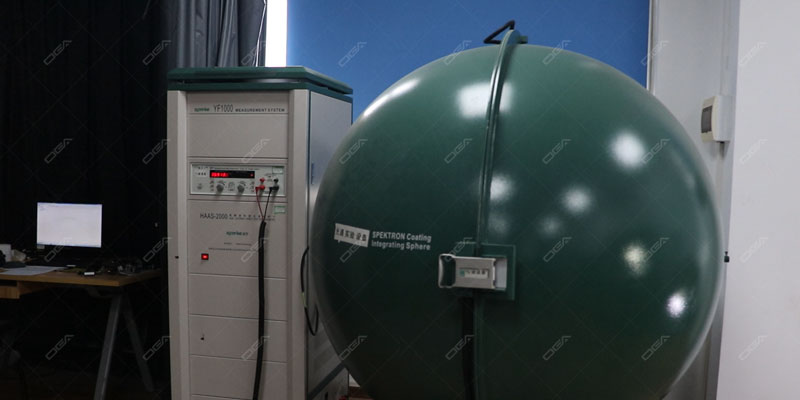Bulk purchasing for automotive LED lights can turn into an utterly painful process with every manufacturer and their online website throwing specifications at you about whatever lighting system they are using. Today we will explain some of the definitions and the differences between the terms that are used to quantify and measure the output of light such as Lumen and Lux. We get questions about this all the time because they're the measurements you certainly going to come across. All this information combined is going to give you an excellent understanding of what these terms mean and help you analyze the performance of light when it comes time for you to decide what to purchase.
But what do they really mean, what do we use them for and how come we're always hearing about it. You might have not heard of Lux, but you've definitely heard of Lumen. A common misconception we often hear a lot about is that the more Lumens a light has, the better the light's got to be. So is the light or light bar with the most Lumens actually going to be the brightest and the best performing light? In short, the answer is not necessarily. We're going to have to use a combination of all the terms that we talked about today in order to figure out which lights are going to be best for the needs.
We have seen some auto light manufacturers advertise an ever-expanding Lumen output with some light bars supposedly throwing out an outrageous amount of Lumens, a sign showcasing that the Lumen wars have reached to a point of utter ridiculousness. As impressive as those numbers sound, the sad truth of it all is that if even those light bars are coming close to that Lumen output in the real world, which obliviously they are not, it wouldn't really matter all that much. In the end, Lumen is just a poor indicator of how effective a light or light bar operates. Lux is a much better determinant of the actual, real-world effectiveness of a given auxiliary LED light. Specifically Lux at a fixed range.
Lumen vs. Lux
Both Lumen and Lux are measurements of light, but they do it in two different ways that may not seem all that different at first glance, but make a huge difference when you're judging the real-world capabilities of a given LED light or light bar.
Lumen is a base metric or an SI unit that measures the total luminous flux of a light source, which is the quantity of light emitted per a single unit of time, importantly that also means its light shining in all directions. This number is often given to us by the manufacturer of the LED chip itself, companies like Osram, Cree, Lumileds, etc.
Lux is an SI unit of measure of Lumens over a surface area. In fact, one Lux multiplied by one square meter makes one Lumen.
At first glance those two things might seem more or less the same thing, you might even wonder why we add the work of figuring out Lux if it's just Lumen.
The Problem with Lumen
Lumen seems like the most straightforward way to measure the output of lights or light bars, but it has a few significant problems due to the ways they're measured that auto light manufacturers are more than happy to take advantage of.
First and foremost, some automotive light suppliers measure the lumen at the light source itself, therefore the Lumen rating is just a measurement of the raw potential of that light. In the case of off-road auxiliary LED lights and light bars, that means measurements are taken right at the light emitting diode, it doesn't account for anything else that went into the design and the engineering of the light, such as the optics' geometry, reflector's depth, lens' clarity, etc. This poses a serious problem since measuring only at the light emitting diode essentially ignores the rest of the light, especially the part of the light that's arguably just as important as the LED chip itself: the optics.
The optics of light dictate how the light emitted by the diode is getting harnessed, what beam pattern is being produced, and how effective that beam pattern is actually going to be. A given light can have some ridiculous Lumen rating, but if they're using bad optics and not constructed well inside the housing, it's not going to generate a beam that's as effective as a light that has a lower Lumen output but has optics that are designed and constructed well. Granted, auto light manufacturers can put enough Lumens at bad optics to overcome their shortcoming, but by the time they get to that point, they will end up with a light with high power needs that burn amperage from the vehicle's electrical system that's probably better spent elsewhere.
Therefore the only thing we use Lumen for when it comes to automotive LED lights is in headlight, interior and exterior bulbs that don't come with optic design themselves. To measure it we use an integrating sphere which captures all the light shining, and measures it to calculate the total light coming out of that bulb. With most headlight bulbs, we're not concerned about where that light's shining, we just want to know how much total light is coming out of the bulb in all directions because we'll put it in a headlight that has optics to focus on where we need it to be. But the lumen measurement doesn't tell us how bright the light is in different directions, it only tells us the total light coming out of a bulb. You might see some "measured Lumens" values where we actually take the whole lamp and measure it just like we do to a headlight bulb, the problem with that is that includes light going in every single direction.
Lumen measurements work great for bulbs. But when it comes to automotive work lights or light bars, specially E-mark or SAE certified lights, we must be shining light in specific directions, which is why Lumen measurements for work lights or off-road lights really aren't very useful. We want to know how much light is shining on the target. We don't really care how much light is shining way up into the sky if we're trying to light up the road, so the "measured Lumens" value isn't that useful. You might have heard of the term "effective Lumens", and we'll get to that in a second, but the important measurement for automotive work light and light bar is Lux.

Why Lux is Better
While Lumens are more of a measurement of raw potential and refer to the total visible light output produced by a light source, Lux is as totally opposed to the lumen and refers to how much real-world amount of light that a light or light bar is hitting a surface from a specified distance away no matter where it's coming from. Measuring away from the light takes into account both the LED chips themselves and the optics, which gives you a much better idea of how well the light is going to perform out there in the real world. You'll probably notice that lots of light bars don't have Lux stats at all, and it's to avoid looking awful compared to higher-quality light bars.
Lux is a really good measurement of light because it's a real-world measurement, and it's something that accounts for all of the research design, engineering and everything else that went into making that light itself. So what we need is that Lux value, the Lux value is going to tell us how much light is shining exactly in the direction we want it. It's not misleading and you can do the calculation to see how far away that light can shine. While Lux can be cheesed a bit, it can't be outright abused like Lumen values can and often are.
The measurement process is pretty simple, all we do is take a light, keep a certain distance in between, and then shine it on a wall. To measure it, we use a Lux meter with a sensor to get the Lux value, and it'll tell us how much light is coming into that sensor. Typically Lux is measured from 10 meters away, but at OGA LED we do it at 6 meters in our test darkroom. That's important, because if you see Lux values online, they're probably just using a sensor to measure it, but you should always see the distance with that measurement, for example, 7640 Lux at 6 meters. If you don't know how far away it is, it's pretty worthless. Because the light will fall off the further it goes, therefore, Lux is related to distance.
So why do we see Lumen values so much If Lux is what the auto light manufacturers use? It's simply because the Lumen values are much more accessible. For example, if someone wants to make a light, they can just choose a LED chip, and that LED chip manufacturer is going to have a Lumen value saying where the light shines in all directions from that LED chip. If they choose a 1000 Lumen LED chip, they can put two of them in here and then say they got a 2,000 Lumen light. That's horribly misleading because they're going to lose a lot of light as it comes out of that light itself. Besides, the light needs to shine in specific directions, which means not all of the light will go out to where it needs. But still, you'll see some companies call that a "calculated Lumen value" or "rated Lumen value" (we called it "theoretical Lumens", but we always have the "actual Lumens" or "effective Lumens" close beside it), and just be like, 2,000 Lumens, don't even have to measure anything, there it is.
The reason you don't see so many Lux measurements around is that it's much harder to measure. At OGA we have an entire light tunnel dedicated to this measurement and we use a Lux meter with a sensor, and adjust lamps very slowly to take points of measurement in order to determine that full beam pattern and to see what those Lux values are. That's a lot harder than simply reading a data sheet and writing down a number. With a measurement procedure like that, we can also get the last measurement you might have heard of, which is "actual Lumens" or some might call it "effective Lumens", and what that means is, after we measure Lux and get the whole measurement in a beam pattern, we can say, how much light must be shining to create these intensity values in a specifically defined area, it's basically reversing the math back to the total light shining in that specific direction.
That can still be misleading because a lot of the time people don't know how big of an area the measurement includes. If the entire area is included, it's not going to matter because people don't care about the light that's shining in the sky. Looking at the Lux values and the beam pattern plots to see where those Lux values are is the best way to determine whether that light will meet the needs. It's also the way people have to determine whether any lamp is going to be legal to use on the road because people know exactly where the light is shining. While Lux values are a better gauge of light, they are still taken in a very controlled environment with some brand-new, off-the-assembly-line products that are going to give much better Lux values than those being used, out in the field, in different ambient conditions, with dirty lenses, after general wear and tear, etc. So, Lux values should still be taken with a grain of salt.
One really big thing to remember here is that beam patterns do affect Lux values. A spot beam light has a very concentrated hot spot that's very bright because it's meant to throw light out super far down range, that number is going to be a lot higher than other beam patterns. A flood beam or diffused beam light might have a spread beam light that is going to have a much lower Lux than a spot, driving, or combo beam. You'll want to avoid apples to oranges comparison, not because it's any worse of a light, but simply because it's designed to spread light out over a much wider area. So you'll also need to be careful when comparing lights and light bars and only look at the Lux values of lights that have similar beam patterns.

Conclusion
So, when you're bulk-purchasing around for work light or off-road light for your market, let Lux be your guide, and don't get too excited about the latest cheap light bar rocking its massive Lumens but conspicuously lacking a Lux measurement. It probably sucks in all sorts of fun ways that you won't find out about until you tested it. When it comes time for you to determine which auto LED light you should bulk purchase and which offered light is going to perform best for your market, looking at the Lux and Lumen values of the light will help steer you in the right direction.
If you have any other questions about Lumen, Lux, any other lighting measurements, or just about automotive lighting in general, please feel free to leave an inquiry. We hope this article has been useful to you. We're really trying to make it easier to understand the ratings and information we and other automotive light manufacturers provide on the market.





